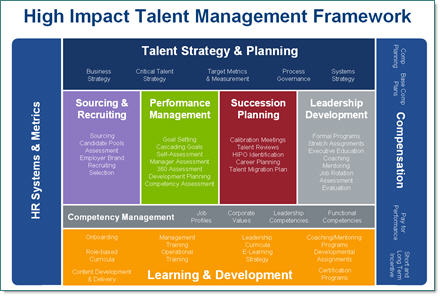After Talent Management: Enter People Management
Business and HR leaders have been focused on integrated talent management for the last three years now, and it is clear that talent management concepts, strategy, and solutions have started to transform HR. Most HR organizations today now have an owner of “talent management” and this person is pulling together formerly silo’d HR processes like performance management, succession management, career management, and leadership development.

Fig 1: Bersin & Associates Talent Management Framework
But something continues to be missing: many of these programs and strategies arevery HR-focused. They are often cost-justified and driven by the HR or L&D organization’s desire to become more aligned and efficient. (I have sat through five presentations called “One-HR” in the last six months). And yes, as we talked about in our research, “Business-Driven Talent Management” is our ultimate strategy. But today many organizations have not yet reached the “business-driven” part of the solution – so the “talent management” strategy looks like an “HR-strategy.”
As we have written about many times in the past, the solution here is to do two things: first, clearly identify and document the business problems you want to address (today this is pretty easy!); second, translate these into the talent strategies you want to implement which support these business problems. If you are transforming yourself from an investment bank to a retail bank, for example, you have many new roles to train, people to migrate, and processes to implement. If you are moving from a healthcare service company to a preventive healthcare company (more on this below), then your talent strategy should include a process of retraining and re-thinking the roles of everyone in the healthcare value chain.
As we discuss in our research “every business strategy has an underlying talent strategy.”
As we talk with literally hundreds of companies over the past few years, we continuously remind them to work on these two levels first. Only after these strategies are in place, can you design and implement your new performance, succession, and career development program.
Economic Downturn Creates a New Focus – An Expanded Role for Talent Management
Now, however, the business world has changed. The critical problems organizations face in 2009 are very different: rapid market changes, restructuring, downsizing, mergers and acquisitions. These problems not only create a need for better alignment and leadership, but a heavy focus on rapid talent planning, employee mobility, rapid skills development, and what we call “business agility.” (You will see a lot more from us on this topic in 2009.) This means that many of the 2006 and 2007 and 2008 concepts of talent management are no longer enough.
Today I hear more and more HR and business leaders telling me “we have our talent management strategy well underway” but what we really need is a “People Strategy.”
What they are really saying is that while the traditional definition of talent management is important, they really need more — and I believe this concept of the “People Strategy” is the next “big thing” coming in the world of business-driven HR.
Consider the challenges of one of the nation’s largest healthcare providers, Kaiser Permanente. This organization has 160,000 employees and is one of the country’s largest insurance providers, healthcare service providers, IT organizations, and facilities management organizations. It is transforming itself from a “healthcare service provider” to a “wellness provider,” which means a tremendous change in focus on preventive medicine. This transition will affect every role in the company, and it is accompanied by tremendous changes in organization structure.
The Concept of the People Strategy
The company’s “people strategy” must include things which go beyond what we would call “talent management:”
- Talent segmentation or “audience analysis” – identifying the critical pools of people in the organization and how they will be managed, compensated, trained, and hired differently. These segments will be used for many purposes: different sourcing and recruiting policies, different compensation programs, different training and career development strategies, and different general management approaches.
- Understanding pivotal talent – the concepts of “pivotal talent” have been around for a few years. Which roles in your organization drive the greatest level of value today – and which will be even more important into the future? If you had only one dollar to spend on development, where would you spend it? When you need to downsize, which roles can you afford to do without? Organizations do not yet know how to identify their pivotal talent, but I believe they will focus on this in the coming years.
- Integrated compensation or total reward strategies – most “talent management” teams are very OD focused. They do not directly integrate with the compensation function yet. But once you think about your organization’s business strategies, talent segments, and pivotal talent, it is now important to consider compensation within the same framework. While “total rewards” may not fit into today’s definition of the talent management strategy (in some organizations it does), it definitely fits into the “People Strategy.” For example, during a downturn, which groups will get lower bonuses and compensation, which will suffer layoffs, and which may in fact see compensation increases? Where and how should we implement pay-for-performance over different pools of talent? Where can we afford to pour more money and where should we hold back?
- Diversity – how will we dovetail our diversity strategy into our talent management strategy? Several HR leaders have asked me why diversity is not included in our framework, and I told them that I have yet to see it included in most organizations’ view. Yet in today’s rapidly changing labor market, diversity is not just a compliance issue, it drives your competitive advantage. If you cannot hire, manage, and operate as a diverse organization your business opportunties will be severly limited. It must be part of the “people strategy.”
- Talent planning – how will we plan, model, forecast, and manage the pool of people we have, the people we need, and their requisite skills and capabilities? This is one of the emerging areas we are studying in early 2009. The term “workforce planning” is widely used today, but in most cases it refers to a system of collecting open headcount. In a “people strategy” workforce planning must be accurate, dynamic, and integrated with the business. For example, can you get a handle on the contingent workforce in your company and identify whether those roles are strategic or tactical and how cost-effective they are? Using highly skilled contingent workers is a business strategy, not just something to account for in HR.
- Career models and deep specialization and skills – most organizations now realize (and I hope all do soon) that their core business is dependent on deep levels of skills within certain critical roles. New books like “Talent is Overrated” have driven home the principle that only by practice (read “training”) can someone become an expert. Where are the critical career models in the organization and how will we allocate resources to build these skills, provide mobility into and out of these roles, and facilitate growth in these roles? How can we create a development planning process at the manager level which drives the skills and mobility we need? While this kind of thinking goes on in L&D today, it must be integrated into the company’s bigger strategies for people.
- Learning Culture and Business agility – a big topic we are now studying. How can the organization “learn” more quickly? When a business downturn hits, one of the first things the CEO says is “how did this happen to us?” “what can we do to prevent this from happening again?” The topics of innovation, leadership, new business growth, harvesting of existing businesses, all depend on the “people strategy.”
So what I believe we are seeing is a “growing up” of the concepts of talent management. Think about where you are in your own organization’s talent management plan. My guess is that if you build a multi-year roadmap, what you will find is that today’s “performance management” project, which turned into an “integrated talent management” program, will soon turn into an integrated “people management” strategy.
We will be publishing much more on this topic in the coming year – and most importantly including examples and case studies at our IMPACT 2009 Research Conference. I personally think it is very important to think ahead and understand that today’s focus on talent management will evolve soon. And remember that in today’s economy your talent management program must be business-driven, focused on your organization’s short and long term strategy, and executed with speed and efficiency.
